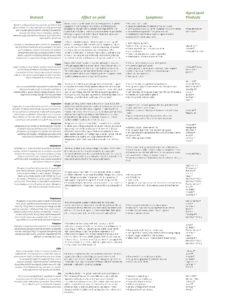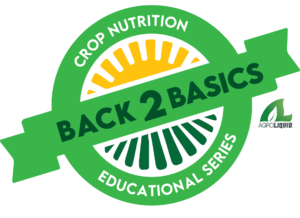As the name suggests, you may not need large doses of micronutrients for optimal plant health, but that doesn’t mean that micronutrient deficiencies don’t exist. Micronutrients are essential elements for plant growth but are required in small amounts. Boron (B), copper (Cu), iron (Fe), manganese (Mn), molybdenum (Mo), and zinc (Zn) are required to complete the life cycle of plant growth.
Reach out to the AgroLiquid team for more information and to answer your questions on the damaging effects of micronutrient deficiencies.
Essential Plant Micronutrients
In general, plants require 16 essential nutrients to grow. The first three are carbon (C), hydrogen (H), and oxygen (O), which plants absorb through water and air. The other nutrients mainly come from the soil, and these are the focus of fertilizer products. Three of these are primary nutrients or macro nutrients; nitrogen (N), phosphorus (P), and potassium (K). Another three are considered secondary nutrients; sulfur (S), Calcium (Ca), and Magnesium (Mg). The remaining nine nutrients are micronutrients; boron (B), copper (Cu), iron (Fe), manganese (Mn), molybdenum (Mo), nickel (Ni), and zinc (Zn). Though plants require micronutrients in small amounts, it can also be easy to miss a micronutrient deficiency. Many other elements, such as chlorine, cobalt, aluminum, selenium, and others, can be beneficial in very small amounts, but are generally not considered essential to plant growth. Keep in mind that some elements may be considered “essential” to certain plants, and merely “beneficial” to others, or mostly irrelevant to others, so this line can be difficult to draw. In this blog post, we’ve covered micronutrients that are commonly added to soils and used by many different types of plants.
Micronutrient deficiencies in soil are becoming increasingly common. Why is that?
- Increased yields due to various technologies means higher removal of micronutrients from the soil.
- Some micronutrients are no longer contained in high analysis fertilizers and fertilizer materials.
- Any type of land preparation which results in the removal of several inches of topsoil can result in a deficiency of certain micronutrients on the cut areas.
- High phosphorus levels can induce micronutrient deficiencies.
Soil Testing to Assess Micronutrient Deficiencies
When considering adding micronutrients to the soil, it is important to know what the soil already has available. A soil test analysis that includes micronutrients will give a snapshot of what is available to the plant. The soil test is especially important because many micronutrient deficiencies cause similar symptoms in the plant and can be difficult to identify. Deficiencies can be caused by many factors, such as soil pH, moisture, temperature, and the presence of other compounds or nutrient tie up. If a crop is not reaching its full potential, or the same problems keep appearing, contact your crop nutrition expert to help investigate potential micronutrient deficiencies.
 Boron Deficiency
Boron Deficiency
Boron is a micronutrient necessary for cell division and differentiation. It is also important for early growth and aids in pollen tube formation, making it essential for reproduction. Boron helps to maintain a balance between sugar and starch in the fruit, and it aids in the translocation of calcium.
How boron deficiency looks
A plant showing stunted and deformed growth are one of the most common representations of a boron deficiency. A boron deficiency affects your plants’ roots and shoots, where roots become thick and short with swollen root tips. As a boron deficiency progresses, your older leaves will look dark green and glossy, while new growth will be brittle or leathery to the touch. Newer leaves may also take on a rust-like appearance.
Affect on Yield
Boron is needed continuously in the growing points of all plants. Because it aids in the movement of calcium to these points, affecting the strength of the cell walls, it is important for high-quality fruit production. Boron is also essential for the germination of the pollen grains and pollen tubes in plants and has a direct affect on yield. No pollination, no crop.
AgroLiquid boron-containing products
 Copper Deficiency
Copper Deficiency
Copper catalyzes several plant reactions and is essential to chlorophyll formation and seed production. It is required for electron transfer during photosynthesis. Copper is also an enzyme activator in plant respiration and a component of numerous enzymes.
How copper deficiency looks
A copper deficiency will affect the newer leaves at the top of the plant as well as growth points. The new leaves will take on a stunted or wilted appearance, with spots of necrosis. Depending on the plant species, leaves can take on a bluish-green tint and display interveinal chlorosis, where the leaf turns yellow but the veins remain green. Mature leaves may begin to fall off and flower development will be impaired.
Affect on yield
Copper aids in root metabolism and the utilization of proteins. Although copper deficiencies are not common, they can occur in western soils and will normally be more visible in cereal crops. Elemental copper can be toxic at low levels and application is rarely recommended as a nutritional supplement. Copper is most readily available on soils with a pH of 6.5 or lower.
AgroLiquid copper-containing products
microLink™ Copper, Micro 500™, FASE1™, Micro 600, Micro 1000
Iron Deficiency
Iron is a micronutrient required for the formation of chlorophyll in plant cells. It activates respiration, photosynthesis, and symbiotic nitrogen fixation. Iron is required for energy transfer and also promotes flowering and fruit set.
How iron deficiency looks
One of the tell-tale signs of an iron deficiency is interveinal chlorosis – in this case, it’s the younger and emerging leaves that take on a paler or yellow color while the leaf veins remain darker. You may also notice new shoots dying off, starting at the tip. If allowed to progress, a severe iron deficiency will lead to your leaves turning white.
Affect on Yield
Deficiency is common where manganese concentration is high or excess free lime exists. Poorly aerated soils and sometimes high zinc levels will also increase deficiency. Low iron levels in the plant result in poor energy transfer from leaves to growing points or fruiting structures, thus slowing growth and lowering yields. Iron is most readily available in soils with a pH of 6.5 or lower.
AgroLiquid iron-containing products
Micro 500™, Micro 600, Micro 1000, microLink™ Iron, Pro-Germinator®, GrowRight™, FASE1™, accessS™, FertiRain™, Fase2™
 Manganese Deficiency
Manganese Deficiency
Manganese serves mainly as an activator for enzymes involved in plant growth processes. It is needed for phosphorus and magnesium uptake and aids in the utilization of nitrogen. Manganese also aids in the production of chlorophyll for photosynthesis.
How manganese deficiency looks
The most common symptom of a manganese deficiency is interveinal chlorosis in younger leaves, where the leaf will turn pale or yellow while the veins remain green. In the case of a manganese deficiency, the leaf edges may also remain green. Leaves may also take on dark or necrotic spots. A manganese deficiency will drastically impact growth, impacting roots, shoots, and leaves while also leading to a reduction in overall plant size.
Affect on yield
Manganese increases the availability of phosphorus and calcium to plants, accelerating seed germination and maturity. Because it plays a major role in the production of chlorophyll, it directly affects the health of the crop and influences whether or not a plant reaches maturity. In fruiting crops, it would have an indirect effect on the size, quality, and sugar content of the fruit. Manganese is most readily available in soils with a pH of 6.5 or less.
AgroLiquid manganese-containing products
microLink™ Manganese, Micro500™, eNhance™, accesS™, FertiRian™, FASE1™
 Molybdenum Deficiency
Molybdenum Deficiency
Molybdenum is a micronutrient essential for symbiotic nitrogen fixation in legumes and is needed in very small amounts by most crops. It acts as a catalyst in nitrate reduction and in nitrogen transport and utilization within the plant. Molybdenum may also be associated with disease resistance in plants.
How Molybdenum deficiency looks
A molybdenum deficiency commonly presents itself in the lower, older leaves of the plants, which begin to take on a mottled yellow color at the edges. The rest of the leaves may take on a light green appearance. As this deficiency progresses, you can expect to see necrosis of the leaf edges and leaves can take on a narrow or deformed appearance.
Affect on yield
Deficiency is often observed as nitrogen starvation. It differs from other micronutrients in that its availability decreases with increased soil acidity and increases with soil basicity. Deficiency is most likely on sandy or peat soil with a low pH. It is possible that heavy applications of sulfur may induce a deficiency.
AgroLiquid Molybdenum-containing products
 Zinc Deficiency
Zinc Deficiency
Zinc is a micronutrient that is important in several enzymatic systems within a plant. It is necessary for chlorophyll and carbohydrate production. Zinc controls the production of the plant growth regulator indoleacetic acid (IAA).
How zinc deficiency looks
Like a few other micronutrient deficiencies, a zinc deficiency mainly affects the newest leaves of your plant. You can expect to see interveinal chlorosis, where the leaf turns yellow while the veins remain green. In addition, these leaves may develop spots of necrosis and may also look smaller than expected, with a mottled or bronzed appearance. Due to shorter internodes, new leaves can also grow clustered together in a rosette formation.
Affect on yield
Zinc affects the terminal growth areas of a plant, and these are the first areas of the plant to show deficiency. High yields are impossible without zinc due to its importance in growth, metabolism, and photosynthesis. Zinc is most readily available in soils with a pH of 6.5 or lower, but this is only one factor that affects availability. High soil phosphorus, soil organic matter, biological activity, irrigation, and leaching also play a role in zinc availability.
AgroLiquid zinc-containing products
Micro 500™, Micro 600, Micro 1000, MicroLink Zinc, eNhance™, accesS™, FertiRain™, FASE1™
Plant Nutrient Cheat-Sheet
It can be difficult to remember what affects each nutrient can have on plants, and what a micronutrient deficiency might look like. This PDF can help. This chart describes common nutrient deficiencies and their affects on yields, including primary nutrients, secondary nutrients, and several common micronutrients.
Back 2 Basics
A great, free, resource to learn all about the role that different nutrients play in plant health and development is the Back 2 Basics video series. These short videos take an in-depth look at each of the nutrients that may make a difference in a crop and help to understand the role that each plays. Learning the ins and outs of how one nutrient interacts with another in the soil is a key step in meeting a plants full potential. Register for the Back 2 Basics series here and receive a notification when new episodes become available.


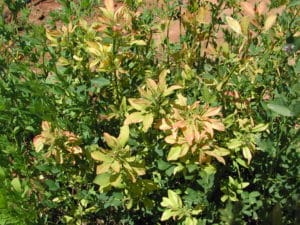 Boron Deficiency
Boron Deficiency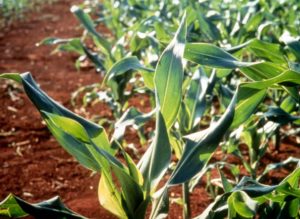 Copper Deficiency
Copper Deficiency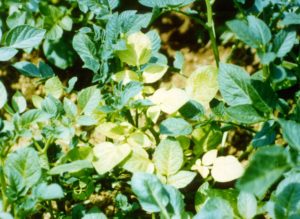
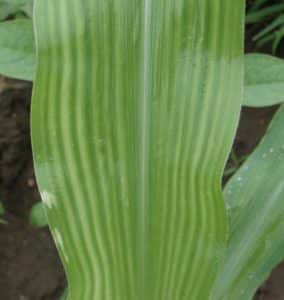 Manganese Deficiency
Manganese Deficiency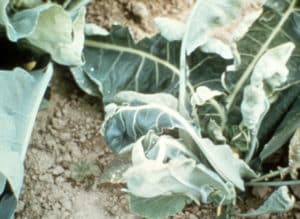 Molybdenum Deficiency
Molybdenum Deficiency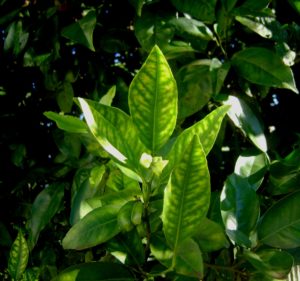 Zinc Deficiency
Zinc Deficiency